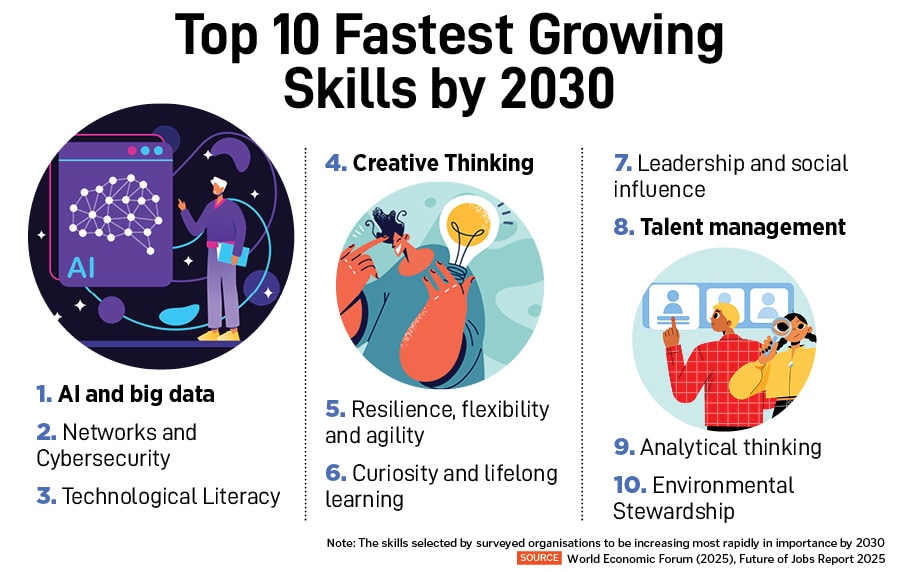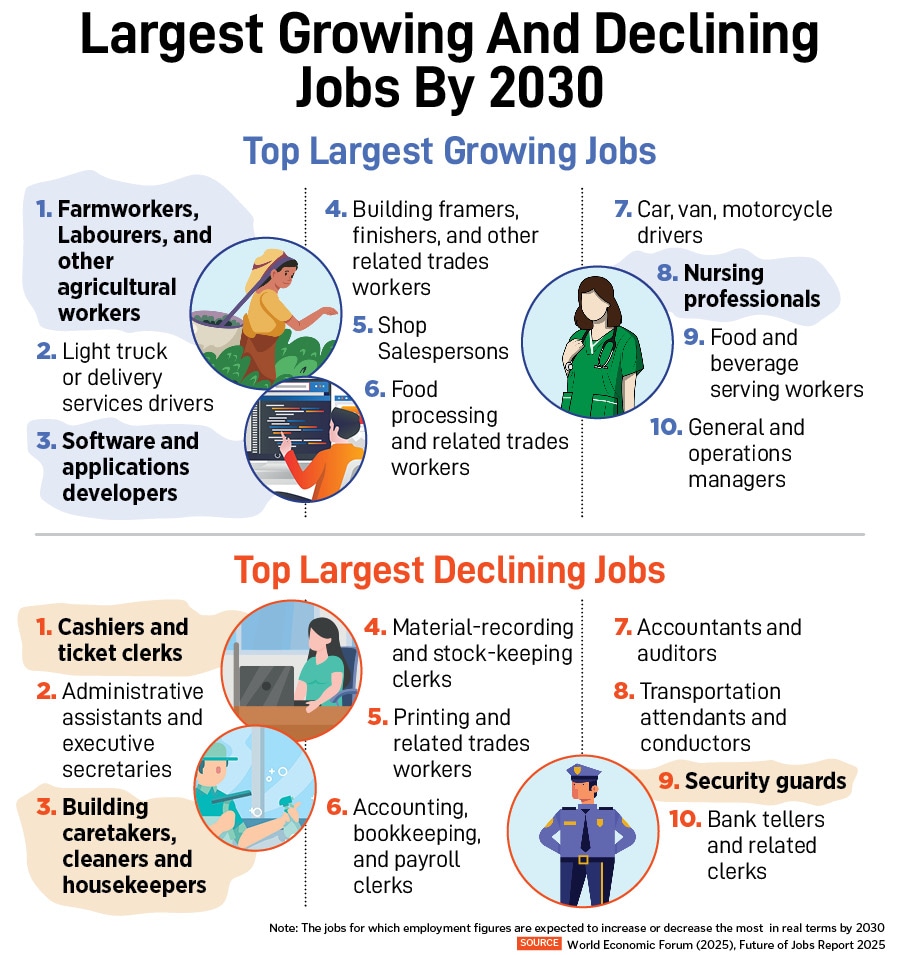Drawing on data from over 1,000 companies, the report says that the skills gap remains the primary challenge to business transformation today. Nearly 40 percent of the skills required for jobs are expected to evolve, and 63 percent of employers already recognize the skills gap as a critical barrier to their success. In particular, technology skills in areas such as artificial intelligence (AI), big data, and cybersecurity are anticipated to see significant growth in demand. Nonetheless, human-centric skills—including creative thinking, resilience, flexibility, and agility—will remain indispensable for success. As businesses adapt to an increasingly dynamic environment, a combination of both technical and human skills will be essential to thrive in the future job market.
The report also identifies key sectors set for notable job growth, which include frontline roles in vital sectors such as health care and education that are projected to experience the highest demand by 2030. Simultaneously, advancements in AI and renewable energy are expected to drive increased demand for specialised technology roles. The reports suggest that as industries continue to evolve, the ability to adapt and engage in continuous reskilling will be crucial for both individuals and organizations to succeed in this rapidly changing landscape.
By 2030, frontline roles such as farm workers, delivery drivers, and construction workers are projected to experience the most significant growth in terms of job numbers. In addition, care professions, including nursing, and education roles, such as secondary school teachers, are also expected to see substantial demand increases. These trends are largely driven by demographic changes, particularly the aging population in many regions, which is spurring growth in essential sectors like health care and education.
At the same time, advances in artificial intelligence (AI), robotics, and energy systems—especially in the fields of renewable energy and environmental engineering—are set to drive up demand for highly specialised roles in these areas. These technological innovations are reshaping industries and creating new career opportunities that require specific technical expertise.
However, certain roles are experiencing rapid decline. Positions such as cashiers and administrative assistants, which have long been essential, continue to diminish due to automation and AI advancements. In addition, graphic designers now face job displacement as generative AI tools begin to automate creative tasks, further transforming the landscape of the labour market. As the workforce adapts to these shifts, reskilling and upskilling will be crucial for workers to remain competitive in an increasingly automated world.
Also read: Hard to Soft Skills: How to work with transition in rapidly transforming organisations
Skills gap: A big worry
The skills gap remains the foremost challenge to business transformation in the context of global macro trends, with 63 percent of employers identifying it as the primary obstacle to future-proofing their operations. As industries adapt to rapid technological advancements and evolving economic pressures, the demand for new skills is increasing across the workforce. According to projections, if the global workforce were represented by a group of 100 individuals, 59 would need to undergo reskilling or upskilling by 2030 to meet the changing demands of the job market. However, of these 59 workers, 11 are expected to lack access to the necessary training and development opportunities. This equates to over 120 million workers worldwide who are at medium-term risk of redundancy, as their current skills may become obsolete in an increasingly automated and technology-driven labour market.
The skills gap not only represents a challenge for individual workers but also poses a significant threat to businesses seeking to maintain competitiveness and innovation. With the rapid pace of change in fields like artificial intelligence, cybersecurity, and big data, organisations must prioritise strategic investments in employee development to ensure their workforce remains adaptable and equipped for the future. Additionally, efforts to bridge this gap will require collaboration among employers, governments, and educational institutions, all of which must work together to create effective reskilling programs and initiatives that reach the workers most at risk. Failing to address this issue could result in significant disruption to the global labour market, with millions of workers facing unemployment or being left behind in the future economy.

Others factors driving change in the labour market
Beyond skills, the rising cost of living is expected to significantly impact business models. While global inflation has somewhat eased, the report forecasts that price pressures and slower economic growth will result in the displacement of approximately 6 million jobs worldwide by 2030. As a result, there is a growing demand for resilience, agility, flexibility, and creative thinking—skills that will be essential for individuals and organizations to navigate these economic challenges successfully.
In addition to economic factors, demographic shifts are playing a pivotal role in reshaping labour markets. The aging populations in higher-income countries are driving an increased demand for healthcare roles, while in lower-income regions, the expansion of the working-age population is contributing to growth in the education sector. To address these changes, the report suggests, businesses and governments will need to prioritize workforce strategies aimed at enhancing talent management, teaching, and mentoring skills. These strategies will be crucial to bridge the gaps in supply and demand for skilled labour across different sectors and regions.
Geopolitical tensions, which are a growing concern for 34 percent of businesses globally, are another critical factor shaping the future of work. Alongside these tensions, trade restrictions and shifts in industrial policy are altering global supply chains and influencing business operations. In response, many companies are exploring offshoring and reshoring strategies to adapt to changing trade dynamics. These geopolitical pressures are also driving an increased demand for specialized skills, particularly in cybersecurity, as organizations seek to safeguard their operations from emerging threats in a more uncertain global environment.
What does it mean for India?
According to Kamal Karanth, co-founder, Xpheno, a specialist staffing company, the report findings augur well for geographies like India that possess high talent density and demographic dividend. “The 78 million net new jobs projected is encouraging, especially when India is part of a small cohort of nations that would supply nearly two-thirds of new workforce entrants in the coming years. On the other hand, the job displacements and disruption through AI and technology also present potential opportunities to India.”
Karanth believes that the services-centric tech powered jobs wave that India is known to ride well, will give us an edge in drawing a significant slice of displacement linked job opportunities. “India has an early lead in the AI and GenAI space with a healthy enterprise buy-in and sponsor already in play. India is pitched to be ahead of global averages on parameters like AI exposure, DEI priorities, upskilling and redeployment by or before 2030. The lower structured labour-market churn of 20 percent and 37 percent of talent not requiring training by 2030, are factors in favour. Overall the report is good news on many fronts for India’s talent ecosystem,” says Karanth.
Need for change
The report suggests urgent and coordinated action from governments, businesses, and educational institutions to address the profound shifts effectively. The priority among these is the need to bridge the skills gap, which can be achieved by heavily investing in reskilling and upskilling initiatives that empower workers to acquire the new competencies necessary for emerging roles.
A key aspect of these efforts must include ensuring that workforce transitions are equitable and inclusive, providing all workers—regardless of their background, location, or current skill level—with the tools and opportunities to succeed.
The report also suggests that governments and businesses should collaborate to provide social safety nets, job placement services, and ongoing learning opportunities that help individuals navigate changes in their careers. By prioritising these strategies, all stakeholders—governments, businesses, and educational institutions—can play a pivotal role in fostering a resilient and adaptable global workforce.


